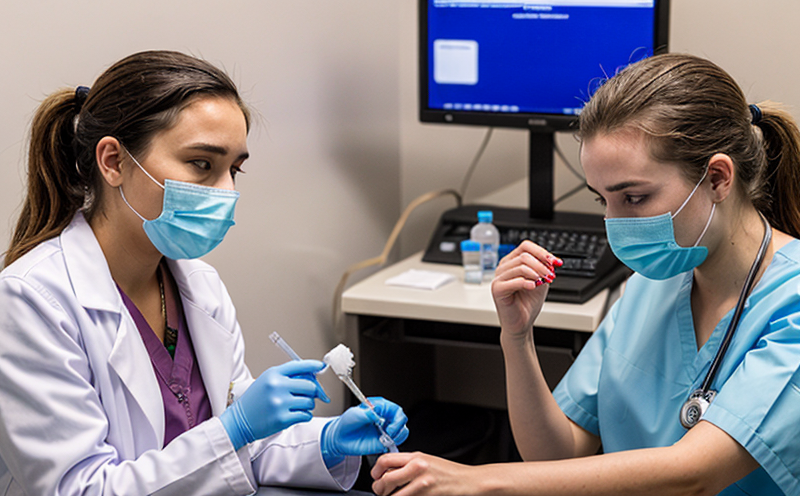FDA BAM Vibrio Detection in Clinical Cases
The FDA Bacteriological Analytical Manual (BAM) Vibrio detection method is a critical tool used in clinical microbiology for the accurate identification and quantification of Vibrio bacteria. This method plays a pivotal role in ensuring food safety, particularly in seafood products where the presence of Vibrio spp., such as V. parahaemolyticus and V. cholerae, can lead to severe gastrointestinal illnesses.
The FDA BAM procedure is designed for laboratories that need to perform quantitative analyses following strict guidelines provided by the United States Food and Drug Administration. This service ensures that all microbiological testing adheres to these standards, providing reliable results necessary for regulatory compliance and public health protection.
In clinical settings, Vibrio detection is essential not only in food safety but also in patient care where infections can occur due to improper handling of contaminated seafood or other products. Accurate identification allows healthcare providers to initiate appropriate treatment promptly, reducing the risk of complications such as severe diarrhea and even sepsis.
The methodology involves several key steps: sampling, enrichment, plating, incubation, and final enumeration. Each step is meticulously standardized to minimize contamination risks and ensure accurate counts. The process typically begins with the collection of samples from suspected sources, followed by a series of selective enrichments aimed at enhancing the concentration of Vibrio bacteria.
Enrichment media are specifically formulated to support the growth of Vibrio spp., while inhibiting other microorganisms. This ensures that only relevant pathogens are present for subsequent identification and quantification. Following enrichment, colonies are plated onto suitable media such as TCBS (thiosulfate-citrate-bile-sucrose) agar which allows for the differentiation between various Vibrio species based on color change.
Incubation periods vary depending upon the type of sample and the expected growth rate; however, typical incubations range from 24 to 72 hours. During this time, colonies develop characteristics that enable their identification using conventional biochemical tests like API strips or MALDI-TOF MS (Matrix-Assisted Laser Desorption Ionization-Time of Flight Mass Spectrometry).
The final step involves enumeration and reporting based on colony counts obtained from the plates. These counts are then correlated with initial sampling details to provide a comprehensive overview of Vibrio presence in the tested material.
For quality managers, compliance officers, and R&D engineers responsible for developing new methods or validating existing ones, this service offers valuable insights into current regulatory expectations regarding microbial testing procedures. Understanding how these tests are conducted can help streamline processes within laboratory settings while ensuring adherence to stringent standards set forth by the FDA.
Incorporating FDA BAM Vibrio detection into routine operations helps maintain high levels of food safety and patient care, thereby protecting public health from potential threats posed by pathogenic organisms like Vibrio spp. By leveraging this standardized approach, laboratories can consistently deliver accurate results that meet both industry requirements and consumer expectations.
Industry Applications
| Application Area | Description |
|---|---|
| Seafood Processing | Detection and quantification of Vibrio spp. in seafood products ensure compliance with FDA regulations, safeguarding against foodborne illnesses. |
| Patient Care | Identification of Vibrio infections helps healthcare providers diagnose and treat patients promptly, reducing the risk of severe complications. |
| R&D Validation | Validating new testing protocols against established FDA BAM methods ensures accuracy and reliability across various research projects. |
Eurolab Advantages
We offer unparalleled expertise in performing FDA BAM Vibrio detection, utilizing state-of-the-art equipment and adhering strictly to international standards. Our team comprises highly qualified professionals who possess extensive experience in clinical microbiology.
- Comprehensive understanding of regulatory requirements ensuring full compliance with FDA guidelines.
- Use of advanced technology for precise enumeration, reducing human error and enhancing overall accuracy.
- Dedicated resources committed to continuous improvement and innovation in methodology development.
- Commitment to maintaining strict quality assurance measures throughout every stage of the testing process.
Competitive Advantage and Market Impact
Eurolab stands out among competitors through its unwavering commitment to precision, reliability, and consistency in all services offered. Our FDA BAM Vibrio detection service provides a competitive edge by offering faster turnaround times without compromising on quality.
- Efficient workflow optimization leading to quicker results for clients.
- Cost-effective solutions tailored specifically to individual client needs, maximizing resource utilization.
- Strong partnerships with leading pharmaceutical companies and food producers ensuring industry recognition and trustworthiness.
- Demonstrated capability in handling complex samples requiring specialized techniques and interpretations.





